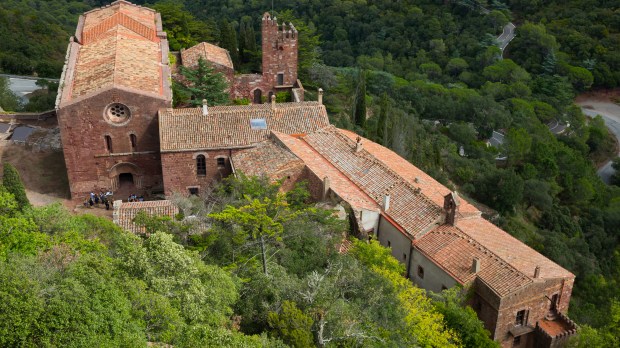The mountains of Catalonia, in North Eastern Spain, are dotted with castles, chapels, hermitages, abbeys, monasteries, and castle-monasteries. One of these fortified monastic buildings is the noted Monestir de Sant Miquel d’Escornalbou, a monastery built in the 12th century for religious and military purposes.
In medieval times, the Escornalbou mountain marked the border between Christian and Muslim lands. Indeed, many Saracens fleeing the Reconquest settled there, because of its relative inaccessibility. The Catalan Christianization was completed after the conquest of Siurana (a village high atop one of the many hills in the Priorat region of Tarragona) in 1153. Not even a decade later, in 1162, a raid was organized in Escornalbou, and the last Moorish refugees from the mountain had to flee to the south.
Once the region was conquered, King Alfonso II of Aragon ceded the mountain to a canon of the cathedral of Tarragona known as Joan de Sant Boi. The only conditions the king imposed were the construction of a chapel dedicated to St. Michael and a monastery for the canons who would take care of it. But since the area was surrounded by the very same thick forests that served as a refuge for Saracens and fugitives, the monastery had to be fortified by high walls. The monastery would therefore also fulfill defensive military functions. The remains of a nearby ancient Roman fortress were used as a quarry. Indeed, part of the fortress is built on top of it.

One of the most striking features of this monastery is its sober, exquisite Romanesque architecture — in particular, the chapel of Saint Michael, which stands as a testament to medieval craftsmanship, with its robust yet graceful arches, and a its simple and elegant façade. But little more has been properly preserved. The reasons are (sadly) quite simple.
For more than six centuries, the complex belonged to local noblemen from the Barony of Escornalbou. But in 1835, a set of decrees were issued that resulted in the expropriation and privatization of monastic properties in Spain – the Desamortización de Mendizábal. After this privatization, the monastery was practically in ruins, until it was acquired by the Catalan Egyptologist and philanthropist Eduard Toda in 1911. He reformed it following a very personal interpretation – and the Catalan bourgeois fashion of the time. Some of the buildings were demolished, towers were erected in a rather “exotic” medieval style, and spaces were reconverted to adapt them to the needs and tastes of the owner.
The result is still visible today: of the old monastery only the Romanesque church, some remains of the chapter house, and the structure of the cloister remain. The castle was fully converted into a stately home, where some of the main figures of the Catalan Renaixença would meet in the early 20th century. And still, pilgrims and visitors can walk around the ancient roads that monks used while they guarded the monastery: the lesser-known Camino de los Frailes, one of the many pilgrimage routes in Spain.



